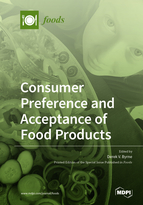Consumer Preference and Acceptance of Food Products
A special issue of Foods (ISSN 2304-8158). This special issue belongs to the section "Sensory and Consumer Sciences".
Deadline for manuscript submissions: closed (20 February 2020) | Viewed by 81078
Special Issue Editor
Interests: sensory science; consumer science; food and beverage product quality; nutrition and eating; multisensory effects; crossmodal interactions; sensory methods; food uniqueness
Special Issues, Collections and Topics in MDPI journals
Special Issue Information
Dear Colleagues,
Acceptance and preference of the sensory properties of foods are among the most important criteria determining food choice. Sensory perception and our response to food products and finally food choice itself are affected by a myriad of intrinsic as well as extrinsic food factors. There is much empirical research showcasing the effect that our senses have on our perception, affective response to food products and our food choices. This effect of the senses is of course affected both by intrinsic food product factors as well as extrinsic (non-food) factors.
The big question regards how these factors specifically affect our acceptance and preference for foods, both in and of themselves and in combination in various contexts, both fundamental and applied. In addition, there is the question of which factors overall play the largest role in how we perceive and behave towards food in daily life. Finally, there is the question of how these factors can be utilized to affect our preferences and final acceptance of real food and food products from industrial production and beyond for healthier eating. We are interested in many aspects in this field, but specifically in the determination of factors, fundamental interactions, and crossmodal effects in different contexts and eating scenarios, and depending on cultural differences. We are also interested in studies that utilize unique study design approaches and methodologies. Both research papers and review articles are welcome in this Special Issue of Foods.
Prof. Dr. Derek V. ByrneGuest Editor
Manuscript Submission Information
Manuscripts should be submitted online at www.mdpi.com by registering and logging in to this website. Once you are registered, click here to go to the submission form. Manuscripts can be submitted until the deadline. All submissions that pass pre-check are peer-reviewed. Accepted papers will be published continuously in the journal (as soon as accepted) and will be listed together on the special issue website. Research articles, review articles as well as short communications are invited. For planned papers, a title and short abstract (about 100 words) can be sent to the Editorial Office for announcement on this website.
Submitted manuscripts should not have been published previously, nor be under consideration for publication elsewhere (except conference proceedings papers). All manuscripts are thoroughly refereed through a single-blind peer-review process. A guide for authors and other relevant information for submission of manuscripts is available on the Instructions for Authors page. Foods is an international peer-reviewed open access semimonthly journal published by MDPI.
Please visit the Instructions for Authors page before submitting a manuscript. The Article Processing Charge (APC) for publication in this open access journal is 2900 CHF (Swiss Francs). Submitted papers should be well formatted and use good English. Authors may use MDPI's English editing service prior to publication or during author revisions.
Keywords
- food acceptance
- food preference
- consumer
- sensory perception
- food choice







